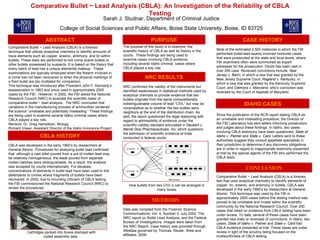
Comparative Bullet Lead Analysis Reliability Questioned
- 1. Comparative Bullet ~ Lead Analysis (CBLA): An Investigation of the Reliability of CBLA Testing Sarah J. Studnar, Department of Criminal Justice College of Social Sciences and Public Affairs, Boise State University, Boise, ID 83725 ABSTRACT Comparative Bullet ~ Lead Analysis (CBLA) is a forensic technique that utilizes analytical chemistry to identify amounts of trace elements such as copper, arsenic, antimony, and tin within bullets. These tests are performed to link crime scene bullets to other bullets possessed by suspects. It is based on the theory that every batch of lead has a unique elemental makeup. These examinations are typically employed when the firearm involved in a crime has not been recovered or when the physical markings of a fired bullet are too mutilated for comparison. This technique was introduced after President John F. Kennedy’s assassination in 1963 and since used in approximately 2500 cases by the FBI. However, in 2002, the FBI asked the National Research Council (NRC) to evaluate the scientific basis of comparative bullet ~ lead analysis. The NRC concluded that variations in the manufacturing process of ammunition rendered the science “unreliable and potentially misleading.” These findings are being used to examine several Idaho criminal cases where CBLA played a key role. Mentors: Dr. Greg Hampikian, Biology Richard Visser, Assistant Director of the Idaho Innocence Project CBLA HISTORY CBLA was developed in the early 1960’s by researchers at General Atomic. Procedures for analyzing bullet lead confirmed that although a cast billet poured from a pot of molten lead may be relatively homogeneous, the leads poured from separate molten batches were distinguishable. As a result, the analysis was accepted by courts internationally. For decades, concentrations of elements in bullet lead have been used to link defendants to crimes where fragments of bullets have been recovered. In 2002, due to mounting criticism of CBLA testing, the FBI commissioned the National Research Council (NRC) to review the procedures. Cartridges packed into boxes stamped with coded assembly data. NRC RESULTS NRC confirmed the validity of the instruments but identified weaknesses in statistical methods used by analytical chemists to provide evidence that two bullets originate from the same compositionally indistinguishable volume of lead “CIVL” but may be nonprobative as to whether the two bullets were neighbors at the end of the distribution chain. As well, the report questioned the legal reasoning with regard to admissibility of evidence under the scientific-validity standard articulated in Daubert v. Merrel Dow Pharmaceuticals, Inc. which questions the admission of scientific evidence at trials conducted in federal courts How bullets from two CIVL’s can be arranged in many boxes CASE HISTORY Most of the estimated 2,500 instances in which the FBI performed bullet-lead exams involved homicide cases that were prosecuted at the state and local levels, where FBI examiners often were summoned as expert witnesses for the prosecution. Doubt has been cast in over 250 case. Reversed convictions include: New Jersey v. Behn , in which a new trial was granted by the New Jersey Supreme Court, Ragland v. Kentucky , in which a new trial was granted by the Kentucky Supreme Court, and Clemons v. Maryland , who’s conviction was reversed by the Court of Appeals of Maryland. IDAHO CASES METHODS Data was compiled from the Forensic Science Communications, Vol. 4, Number 3, July 2002, The NRC report on Bullet Lead Analysis, and the Federal Bureau of Investigations. Images were taken from the NRC Report. Case history was provided through Westlaw governed by Thomas, Reuter, West and affiliates, 2009. PURPOSE The purpose of this study is to examine the scientific history of CBLA as well its history in the courts. These findings are being used to examine cases involving CBLA evidence including several Idaho criminal cases where CBLA played a key role. CONCLUSION Comparative Bullet ~ Lead Analysis (CBLA) is a forensic test that uses analytical chemistry to identify elements of copper, tin, arsenic, and antimony in bullets. CBLA was developed in the early 1960’s by researchers at General Atomic. This technique was used by the FBI in approximately 2500 cases before this testing method was proved to be unreliable and invalid within the scientific community by the National Research Council. Over 250 cases that relied on evidence from CBLA testing have been under review. To date, several of these cases have been granted new trials or reversals of convictions. In Idaho, two cases; State of Idaho v. Palmer and State v. Card had CBLA evidence presented at trial. These cases are under review in light of the scrutiny being focused on the trustworthiness of CBLA testing. Since the publication of the NCR report stating CBLA as an unreliable and misleading procedure, the Director of the FBI Laboratory has sent letters informing prosecutors and judges about these findings. In Idaho, two cases involving CBLA testimony have been questioned; State of Idaho v. Palmer and State v. Card . Letters sent to these authorities suggest they consult appellate specialists in their jurisdiction to determine if any discovery obligations are in order in regard to inappropriate testimony presented at trial by the special agents of the FBI who performed the CBLA tests.